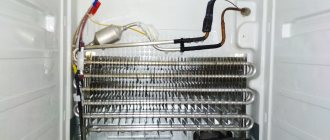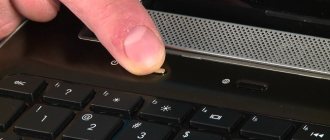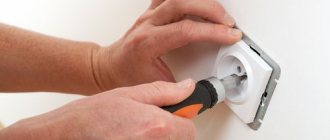Why doesn't the microwave heat up, but the plate rotates and the light is on? The fan is humming and the food is cold. What to do and where to go? When the equipment, which now costs a lot of money and is very necessary in the kitchen, can not be thrown out, but simply repaired, all the knowledge on repairing electrical appliances is used. To achieve a positive result, only basic knowledge of the device itself and microwave electronics is required, or, in extreme cases, the simplest skills of searching for data on the Internet.
There are a number of reasons why the microwave stopped heating and it’s not a matter of broken parts, for example:
- The network voltage has decreased. The operation of the microwave oven, as well as its heating, can be affected by slight decreases of 20V. As a result, the plate will be heated, but there will be no food in the middle of the vessel. The issue of power outages can be resolved in one day: you just need to go to the store and buy a power supply.
- The network is overloaded. If two powerful appliances are running from the same outlet at the same time, an overload occurs. This issue can be resolved by installing another outlet.
- The door is out of order. As a result of a broken latch, the door does not close tightly and the microwave does not heat food or heats it poorly. Here you can try to repair or completely replace the latches.
- Incorrect mode selection. Very often, after defrosting mode, they forget to switch back to microwaves. Defrosting does not heat the food to the required temperature, and you are already about to disassemble the appliance.
The microwave oven does not heat and makes a loud noise
If you find that the microwave oven turns on but does not heat and makes an unusual sound (for example, buzzing), there are 3 explanations for this:
- The diode has become unusable. This part does not allow current to pass in the opposite direction; the current moves only in one direction. If this part fails, the appliance begins to buzz and does not heat the food;
- it's time to change the capacitor. A capacitor failure leads to the generation of waves and the device hums;
- magnetron failure. A defect in this part may also cause a buzzing or humming noise.
The diode has become unusable. This part does not allow current to pass in the opposite direction; the current moves only in one direction. If this part fails, the appliance begins to buzz and does not heat the food; it's time to change the capacitor.
If you decide to find the reason and repair the microwave yourself, then keep in mind that this is a dangerous device. Even if the microwave is unplugged from the network, there is a high probability of electric shock of high voltage, up to 5,000 V. If you have doubts and are not confident in your own knowledge, then it is better to show the device to a specialist, even for diagnostics alone. There is no need to risk your life, because the device is not worth it.
If you nevertheless decide to produce, then before watching anything, turn off the device from the network. Be sure to find the instructions, which contain the names of all the parts that are there.
Description of the problem and possible causes
This problem occurs frequently, and there can be several reasons for it. The fact is that the rotation of the tray with the product, light and other signs of operation are independent of the “insides” of the microwave oven. It turns out that some of the equipment may fail, but the oven will appear to function correctly. Here are the main causes of such symptoms:
- Blown fuse - If the fuse is blown, it needs to be replaced. Usually there are several of them in a microwave oven, but one blown fuse is enough for the oven to malfunction. Fortunately, they are cheap. But you should not approach fuse replacement carelessly. They protect your kitchen from fire in case of power surges;
- If you hear an extraneous noise when the microwave oven is operating, reminiscent of crackling, then most likely the problem is the capacitor. You can check it using a simple ohmmeter; before this, of course, you need to turn off the device from the network and get rid of the voltage;
- Magnetron is a more costly breakdown for you. The main symptom will be an increased hum when the furnace tries to operate;
- failure of diodes - they are easier to replace than to check, so it is better to think about them last.
This breakdown in itself is very unpleasant. After all, the microwave oven stops working as it should, but only creates an appearance. In addition, if the problem was a short circuit, the situation may only get worse with further attempts to use it.
If food heats up too slowly or doesn't heat up at all, this is a sure sign of oven failure.
In addition to the reasons mentioned, there are a number of things that are worth checking before repairing:
- problems with voltage in the electrical network - if your network produces less than standard voltage, there will be problems with heating food. The most minor changes can lead to unpleasant consequences in the operation of the microwave;
- the power grid is overloaded - when a large number of devices are operating from one network, there may not be enough voltage for everything. As a result, your food will also not be properly heated, although the microwave will work;
- problems with door latches - if the microwave door does not close tightly, the food will not heat up effectively. This problem is easy to detect - just check whether the door moves during operation when exposed to it;
- Choosing the wrong oven mode - accidentally switching the microwave oven to low-power modes can cause confusion when attempting to reheat food. Just check the settings you use when warming up.
If you are sure that there is still a breakdown, you should start identifying and repairing it.
Video: fixing a breakdown using the example of a Samsung microwave
The microwave does not heat: check the fuse
First of all, after removing the cover, you need to make sure that all fuses are working properly. If you see that they have turned black or the thread has burned out, then you just need to replace them. Often there are two fuse parts inside.
When buying a new part, be sure to take the old (burnt out) one. To temporarily solve the situation, it is not recommended to make bugs out of wire. There is a great danger of fire, and the price of a good fuse is no more than 50 rubles.
If the device hums when turned on, there is a possibility that the capacitor has broken. It’s easy to check its serviceability: you need to take an ohmmeter and connect it to the part. If everything is in order, then the ohmmeter needle moves. And if it stops, then the capacitor has failed, and because of this the stove is noisy.
If the device hums when turned on, there is a possibility that the capacitor has broken. It’s easy to check its serviceability: you need to take an ohmmeter and connect it to the part.
Before replacing or checking the capacitor, it must be completely discharged!
If you notice a burning smell or something crackling inside while the microwave is operating, after watching this video you will understand what’s wrong. It shows how you can repair a microwave oven if it sparks.
Why the microwave does not heat: the most common reasons
If the microwave oven does not heat, the reason is most likely due to the following:
- fuses have blown (at the network input and at the transformer terminals, depending on the stove model);
- the high-voltage fuse has failed;
- malfunction of the high-voltage diode of the doubler;
- doubler capacitor failure;
- lack of power to the control panel;
- malfunction of the filter capacitor;
- failure of the magnetron.
All of the reasons listed are listed in order from simple to more complex. You have a useful guideline for eliminating unnecessary costs in both time and money. If it turns out that the problem is solved by simply replacing the fuse, imagine how useless the process of completely disassembling and reassembling the product would be.
Magnetron
If, when checking the device, you did not find any breakdowns, then it is likely that the problem is in the magnetron. The sign by which magnetron failure is determined is strong noise (hum) during operation of the device. If the microwave is humming and not heating, then you need to look at the magnetron to see if there are cracks or carbon deposits there. If the breakdown is not visible visually, then check with an ohmmeter. If the magnetron burns out, then you need to buy the same one. It should have the same parameters and size.
If, when checking the device, you did not find any breakdowns, then it is likely that the problem is in the magnetron. The sign by which magnetron failure is determined is strong noise (hum) during operation of the device.
Preventing damage
We have shared with you information on what to do if the microwave works but does not heat food. It is very important to determine the reason and problem why the microwave stopped heating food. Most often, you don’t have to look for an answer for long: most likely, you used the device incorrectly. In order for your equipment to serve for a long time, you should not do the following:
- heat food in a metal container (a spoon also applies here);
- turn on an empty device (without food);
- warm eggs;
- place containers with lids.
heat food in a metal container (a spoon also applies here); turn on an empty device (without food); warm eggs; place containers with lids.
Over time, any equipment can fail due to wear and tear of spare parts. Equipment made in China can quickly break down due to shoddy assembly; they are used to making quality work only for themselves. If the price of equipment is quite ridiculous, then remember the expression that the miser pays twice. In conclusion of the article, we would like to give you advice: if your microwave oven is under warranty, then under no circumstances open it and do not start looking for a breakdown yourself. Trust qualified employees who will perform diagnostics and carry out work at the expense of the company.
Even if you feel that you can repair the device yourself, know that there is a great danger in any incorrect action. The device has the ability to accumulate electricity and can shock with high voltage. Trust professionals who can determine the problem even just by looking at the device. Your life is much more valuable! Think twice before opening the lid.
Of all the household appliances, the most hard-working one in the kitchen is the microwave oven. It is she who saves our time and helps us out in any emergency situations. Therefore, its unexpected breakdown is very upsetting. What to do if you find that the microwave is not heating?
What malfunctions occur
At some point, you may be upset by a problem - the microwave has stopped heating food. By all signs it is clear that it is broken - it hums, there is no backlight in the chamber, the plate does not spin, the fan does not turn on, the food does not heat up. What to do? You should probably contact a service center to diagnose the problem and make the necessary repairs. If you have experience with electronic equipment, you can try to figure it out yourself.
If the stove is new and under warranty, it is better to simply take it to a service center. Perhaps the malfunction is a consequence of the use of low-quality components and poor factory assembly. In this case, the equipment can be repaired free of charge.
Microwave Oven Troubleshooting
Finding out which of the above reasons is not so difficult. Just follow these steps for a detailed check:
- Measure the voltage at the outlet where the microwave oven is connected. It must meet the standard.
- If everything is fine with it, unplug the microwave oven and make sure it is de-energized. Then remove the cover on top of the oven to gain access to the internal parts of the equipment.
When repairing the stove, it is necessary to remove the cover that is secured with bolts
- The fuse is checked simply visually. If none of them look burnt, then something else is wrong.
- Using an ohmmeter, measure the presence of voltage in the capacitor and diodes. If the ohmmeter needle does not move, the problem is in the capacitor. If there is resistance, it is worth replacing the diode. It still won’t be possible to check it more reliably, but the diode is quite inexpensive.
- And finally, it is worth checking the magnetron itself. Wait for the microwave to cool completely and inspect it visually. Pay attention to the contacts. If you don’t see any problems, it’s worth checking the resistance of the threads. But even if there is the correct resistance (about three ohms), there may be problems with the lamp.
Helpful to know the location of the parts inside the microwave oven
The microwave oven works and does not heat
The situation when the microwave works but does not heat food occurs for many users. How to figure out the cause and what to do if the oven does not hum, the food on the plate is spinning, the ventilation and lighting in the chamber are working. That is, there are all the signs of normal operation, but without the desired result.
The simplest reasons
The microwave will not heat food:
- If there are large voltage drops in the linear network. Already at 200 V, the food in the dish will not heat up completely and will remain cold in the center. To correct the situation, you can use a voltage stabilizer or connect an uninterruptible power supply.
- If the latch on the door is broken and it does not close tightly. It can be repaired or completely replaced.
- When connecting more than two high-power appliances to one outlet. You can additionally make a separate connection.
- If the mode is mistakenly selected incorrectly. For example, they forgot and did not switch it after using the defrost mode.
If the simplest reasons are not suitable for your case, then there is a more serious reason for the lack of heating.
Options for more complex problems
The microwave does not heat but it works:
- Due to a breakdown of the control unit and a malfunction of the timer.
- The reason is in the power circuit - in the high voltage diode, capacitor, fuses, high voltage transformer and magnetron.
With some knowledge, you can find and fix the problem yourself.
In case of any breakdown, we must not forget that a microwave oven is a microwave device that operates at ultra-high frequencies and can be dangerous even when turned off.
Do-it-yourself microwave oven repair for more serious problems
There may be several reasons why the microwave has stopped heating. Most often these are problems:
- control unit (timer malfunction);
- power network;
- fuse (a sudden surge in voltage can damage it);
- capacitor;
- high voltage diode;
- magnetron (the most expensive part of a microwave oven).
Now let’s try to figure out in detail how it is possible to eliminate such breakdowns - how to fix a microwave oven with your own hands.
Repairing a microwave oven with your own hands is possible, but requires care and precision
Do-it-yourself microwave oven repair if the control unit fails and the timer malfunctions
First, unplug the microwave oven, unscrew the screws on the back, and remove the protective cover. Next, we carefully inspect the control board for burnout of conductive paths, swelling, and burnout of elements. It happens that a microwave begins to take on a life of its own – it can spontaneously turn on, turn off, or refuse to work. Here the problem may be a faulty touchpad. In any case, although such parts can be restored, they will not work for long. It is much more cost-effective to purchase a new unit or keyboard, installing them in place of the old ones.
IMPORTANT!
When purchasing replacement parts, choose those marked with the same markings as those previously installed. This way you will save yourself from unnecessary costs. By the way, such purchases cannot be returned or exchanged.
Repair of the control unit - soldering of jumpers to replace burnt tracks
The microwave works, but stopped heating due to problems in the power circuit
This happens quite often. The first step is to check the magnetron circuit fuse (high voltage). If it burns out, the backlight of the microwave oven and the rotation of the platform remain in working order, and power is not supplied to the magnetron (microwave gun). This can be treated by replacing the high-voltage fuse.
This is what a high-voltage fuse looks like in a protective casingWhy does the microwave work but does not heat food: checking the capacitors
The microwave oven circuit contains a multiplier capacitor as well as pass capacitors. All of them should be checked using an ohmmeter (the multimeter also has such a function). They can be the reason why the microwave turns but does not heat. If faulty ones are found, they should be replaced.
It makes sense to check the high voltage diode. If it does not “ring” in either direction, you need to replace it.
High voltage diode - if it does not ring, it should be changed
The microwave oven works, but does not heat: we are looking for the reason in the magnetron
The main and most expensive part of a microwave oven is the magnetron. If all of the above problems are not confirmed, then the problem is more serious than initially thought. Most often, the filament burns out, which can be checked by measuring the resistance. If there is no resistance, then concerns about unnecessary costs are confirmed. This will be the reason that the microwave works, but does not heat. There is no point in repairing the magnetron - the work is quite labor-intensive. It's easier to buy a new one.
Magnetron is the most expensive part of a microwave oven
IMPORTANT!
Before purchasing, copy down the data of the old magnetron and its markings. It is better to take the burnt part with you along with the rewritten markings for comparison.
Troubleshooting
To figure out why the microwave does not heat, you should find one of the reasons that suits your case. After this, the troubleshooting process will be greatly simplified.
Checking the wiring
In good lighting, we make sure that there are no traces of burning on all wires and contacts. We replace the blackened or melted winding, clean the contacts and terminals with a metal brush. You can use fine sandpaper for cleaning.
Oxidized contacts may cause the oven to not operate correctly.
Checking the voltage
Microwave ovens operate reliably at a voltage of 220 V. If the microwave oven does not heat, first of all you need to check the mains voltage. Any working microwave oven will not heat food if the power supply is less than 200 V. What should I do? Connect the uninterruptible power supply.
Checking the serviceability of the door switch
The miniature switch is checked with the back cover of the oven removed using an ohmmeter.
Attention! Be sure to turn off the power to the microwave.
Inspect and check the high-voltage fuse
Upon external inspection, there should be no visible signs of fuse destruction - blackening, characteristic odor, or burnt wire. Using an ohmmeter, or for greater confidence with a tester, we check the resistance of the fuse. If there is slight resistance, we can assume that the situation is not critical.
Doublers status
We measure the capacitor with an ohmmeter. If the arrow does not deviate, there is a break in the device and it needs to be replaced. A small resistance indicates that the capacitor is broken and must also be replaced.
It is better not to check the diode, but to immediately replace it with a new device.
Let's move on to checking the operation of the vacuum tube
Armed with an electrical screwdriver with a protected handle, first of all, by closing the terminals with the housing, we discharge the feed-through capacitors of the lamp. Now you can measure the resistance with an ohmmeter, touching one end of the capacitor terminal and the other to the housing. If the reading fluctuates or is absent at all, the part needs to be changed. The resistance between the contacts is considered normal on the order of 0.1 Ohm.
Transformer primary winding quality
We use a tester to measure the voltage on the winding. When turned on, there should be 220 V. You can check the operation with a simple glass of water. Once you place it in the oven, make sure it is hot. If the water container is cold, it is better to replace the transformer.
The magnetron may be faulty
This is the main part that creates a high-frequency electric field in which the food is heated. You can check the integrity and reliability of the connections of the magnetron with the filter induction coils, feed-through capacitor, and power terminals. If there are problems with this, you can fix them yourself.
What else can you do? Check the filament at the magnetron with a tester. The resistance should be 2–3 ohms. If all of the above is normal, then the microwave does not heat due to a faulty magnetron.
Now all that remains is to buy the failed parts and take the microwave to a specialist. Only in a specialized workshop using special equipment will they be able to make high-quality repairs.
Today it is already difficult to find a person who is not familiar with the work that is used for warming up or. Due to the fact that it, which has become so necessary, is used every day, and sometimes even used incorrectly, problems will arise in the operation of the microwave: it will not heat the food, the plate will not spin in it, or the light will not turn on. Sometimes it even happens that the light is on, the plate is spinning, the fan and grill are running, but the microwave does not heat the food placed inside.
In this article we will analyze in detail the reasons why the microwave does not heat food and what to do about it.
Possible microwave failures
Before you start repairing a microwave oven on your own or hiring specialists, you should determine what kind of malfunction it is:
- The network voltage is less than 220 Volts.
- In inverter microwave ovens, the inverter breaks down.
- Violation in the control circuit: timer or control unit.
- There is a malfunction in the power circuit, consisting of a fuse, a high-voltage diode, a capacitor, a magnetron and a high-voltage transformer.
Causes of microwave failures:
- A metal object gets inside.
- Reheating prohibited foods (such as raw eggs).
- Natural wear and tear of parts.
- A void in the heating chamber that leads to a fire.
Identifying microwave failures and what to do about it?
You can find out the voltage in your outlet where the microwave is connected using a voltmeter, and if it shows that the voltage is really less than the required 220 Volts, you need to install an uninterruptible power supply.
If everything is normal with the voltage, then the microwave is really broken, and the reason why it does not heat should be looked for inside it - in the power circuit:
- Fuse - according to the device diagram attached to the microwave, we find the fuses; if they are blackened or the filament is broken, we simply replace them with the same working ones.
- Capacitor - if it breaks down, a hum or buzzing appears when turned on, the serviceability of the capacitor is checked with an ohmmeter (if the arrow deviates, it is working; if it does not deviate, it is broken). If a malfunction is detected, it should be replaced with a new one, but it must be taken into account that before checking and replacing the capacitor, it must be discharged.
- A high-voltage diode or doubler - an indicator of problems in its operation is the fuse blowing and the appearance of a strong buzzing sound when turned on, since it is very difficult to check it, it is better to replace it immediately with a new one.
- Magnetron - when it malfunctions, you can also hear a hum and buzzing, and when opened, you can see cracks and carbon deposits on the side of it. If its functionality is not visually determined, then using an ohmmeter, we check the feed-through capacitor (it should not be connected to the body of the magnetron itself) and the filament. Having found a problem, we correct it or replace the entire magnetron with one similar or similar in basic design parameters.
If your microwave oven begins to break down almost immediately after it was purchased, it is most likely made from low-quality or defective components.
Whatever the breakdown, you should remember that a microwave oven is one of the most dangerous household appliances and even if not plugged in, it can give a person an electric shock. Therefore, if you do not have the necessary knowledge of electronics, instead of starting to repair the microwave oven yourself, it is better to take it to a specialized workshop.
When equipment breaks down and it is necessary to urgently resolve this issue, every little detail sometimes turns out to be incredibly important. For example, the cause of a breakdown, if it suddenly does not heat, can result in either a serious repair or just a completely trivial problem. In such a case, it would be useful to pay attention to the nature of the malfunction; the details will indicate a likely problem.
Microwave does not heat well - reasons
As soon as you notice that the usual time is no longer enough to warm up or the food remains completely cold, most likely the reason is the so-called magnetron. But this is a rather serious breakdown, we will return to it later. First, let's analyze whether there are any simpler reasons why the microwave stopped heating. And there are enough of them:
- in the network less than 200V (as a result, the radiation power is noticeably reduced, which leads to insufficient heating);
- A common reason why a microwave does not heat is a banal malfunction in the control unit or the timer itself (this is a negligent attitude towards the equipment, its “advanced” age);
- Sometimes the invertron fails (this is a common occurrence for inverter-type equipment);
- The reason why the microwave does not heat well is a problem in the power circuit (the capacitor, diode or fuse may be faulty here).
If the magnetron fails, you will have to give the equipment to a specialist. The reasons why the microwave does not heat due to the magnetron can be malfunctions of various origins.
If the reason why the microwave is not heating food is a faulty diode, you will notice a characteristic buzzing or noise. This indicates that the current only flows in one direction. You will also hear a characteristic hum if the reason why the microwave stopped heating is the capacitor. This section accumulates the field itself, and due to a malfunction, the generation of microwaves does not begin, and this is what gives the same hum. In such a situation, you will have to change some details. That is why it is imperative to give the equipment to a specialist and determine the feasibility of repair, because sometimes this is too expensive.
Some owners of microwave ovens (for example) have encountered the following problem: the device works when turned on, but the food does not heat up. At the same time, the plate rotates, the light is on, even the grill functions, but the food still remains cold or frozen.
Cause of microwave oven failure
The design of MVPs from different manufacturers is practically the same. Korean LG, Samsung, Daewoo, Japanese Panasonic, Supra, Sharp or the British brand Scarlett ") have a similar device. They differ only in small nuances: design, color, control panel, number of bolts. Therefore, our article is suitable for diagnosing and repairing any microwave oven. The food in the oven is heated by electromagnetic radiation generated by a magnetron. Therefore, it is logical to assume that if the stove does not heat, it is the culprit. But since the operation of the magnetron depends on many other parts and systems, you will have to check them too.
The microwave has stopped heating or is taking a long time to heat - what’s the problem?
- The network voltage is less than 220 W. A slight voltage drop may not be noticeable from the outside. The appliance, as usual, rotates the tray, lights up, but does not heat the food well or does not heat the food at all. If your assistant heats up every once in a while, the reason may lie in unstable voltage. Check the voltage in the outlet with a tester.
A reading below 220 W indicates an unbalanced, overloaded network or poor-quality transmission line; problems at the substation are also possible. Network unloading will eliminate this problem - do not turn on many powerful devices at the same time. Install an uninterruptible power supply. If the measures taken do not help stabilize the voltage, contact your electricity supplier: the problem may be a damaged power line.
- Magnetron malfunction.
A malfunction of the magnetron is indicated by sounds atypical for MVP. The device makes noise, hums, buzzes louder than usual, but does not heat well or does not perform the heating function at all. Check the inner walls of the oven - the presence of carbon deposits is a sign that this part has broken. A broken magnetron cannot be detected by a multimeter; it can be replaced by carefully following safety rules.
- The door lock is broken.
If there is no blocking, the heating process will not start. So the developers made sure that microwaves do not harm you through the open door of the device. If the oven is not working, check the shutter mechanism and door hinges. This minor damage is easily fixed by replacement.
- The fuses (or one of them) have blown.
If the microwave begins to heat worse, but the tray is spinning, check the fuses. To get to the fuse, you will have to disassemble the housing. A burnt-out one differs from a serviceable one by the presence of carbon deposits on the glass bulb and a broken spring.
- The capacitor and diode have failed. If the capacitor breaks down, the microwave beeps, heats up weakly, and the ohmmeter needle remains motionless when the signal is dialed. A diode failure causes increased buzzing during the process, and the oven heats poorly. The capacitor and diode must be replaced, and in some cases repaired (for experienced craftsmen).
- The control panel is broken.
It happens that the buttons “stick”, the contacts come loose, and the microwave does not turn on. Try disassembling the control panel, checking the contacts, cleaning the keyboard.
Some of these breakdowns are easy to fix on your own; in difficult cases, you will need the help of a specialist or even purchasing a new microwave.
Do-it-yourself repairs require certain skills and compliance with safety precautions:
- Always unplug equipment before making repairs.
- Always wear special dielectric gloves.
- Use tools with insulated handles.
- Do not operate a disassembled, damaged, open or empty microwave.
- Discharge the capacitor before repairing. For example, use a screwdriver on the housing (up to 1000 volts) or connect the capacitor contacts with pliers if the power is above 1000.
- Do not leave metal objects or tools inside the oven.
- Do not make holes in the housing.
What to do if the MVP heats the dishes and not the food
If your assistant heats the plate itself instead of the contents, you most likely chose the wrong cookware. Microwave dishes should not contain metal, many water molecules, non-heat-resistant plastic, or melanin. These materials interact with electromagnetic waves, heat up, melt, and shiny metal objects reflect particles, creating an electric arc that can cause a fire or short circuit. Therefore, purchase special heat-resistant dishes marked for microwave use.
We have listed the main reasons for such a problem as lack of heating in the microwave. Remember safety precautions. We wish you a successful and easy repair!
Bad 2
Interesting
Super 1











